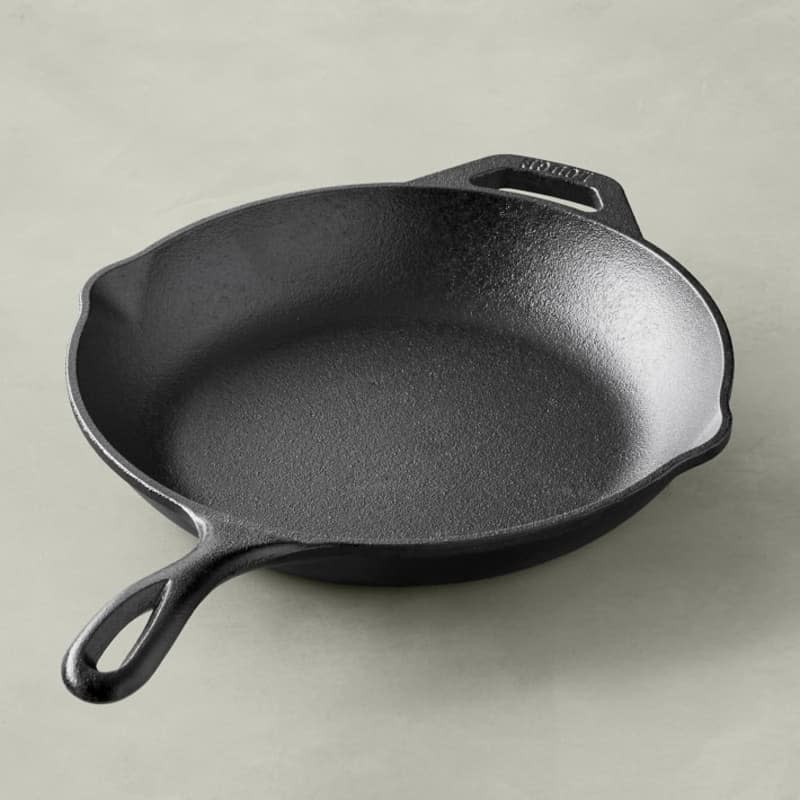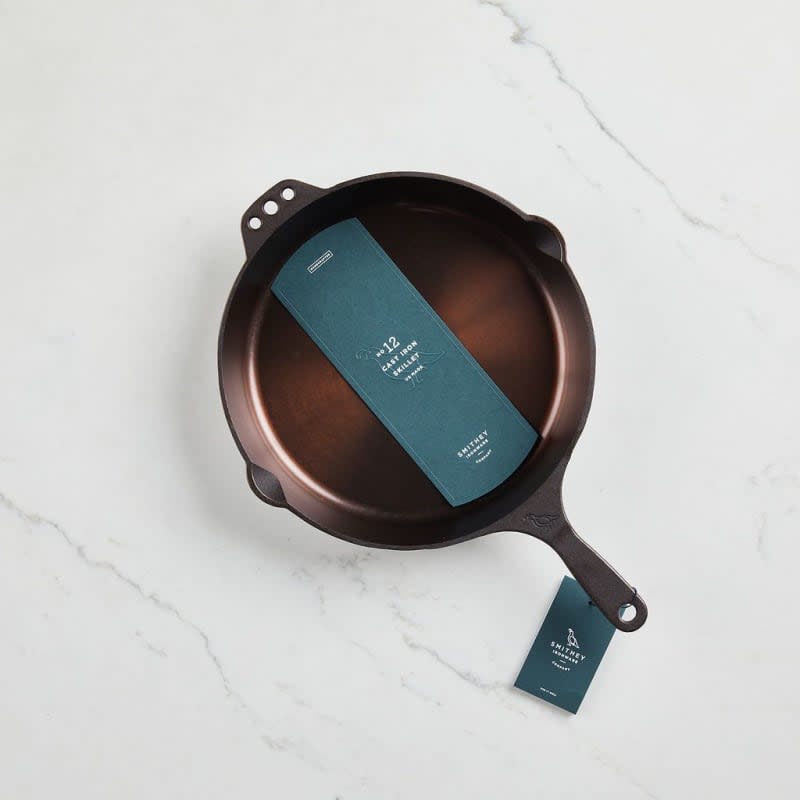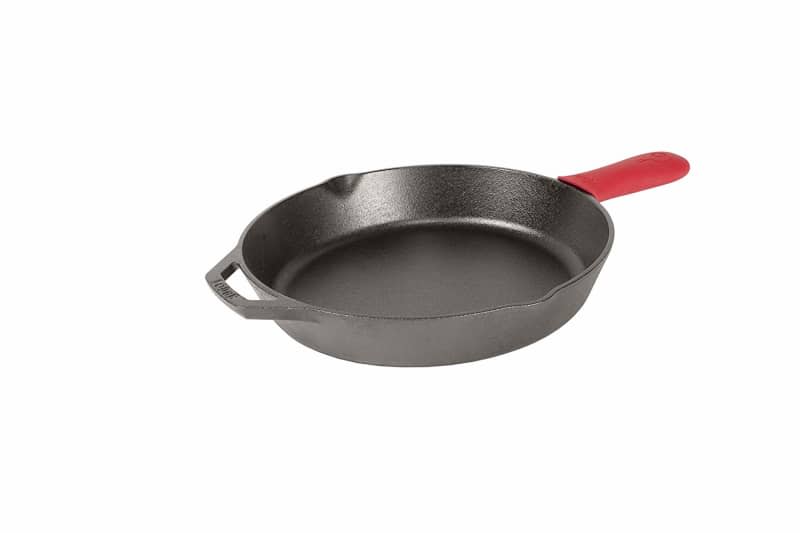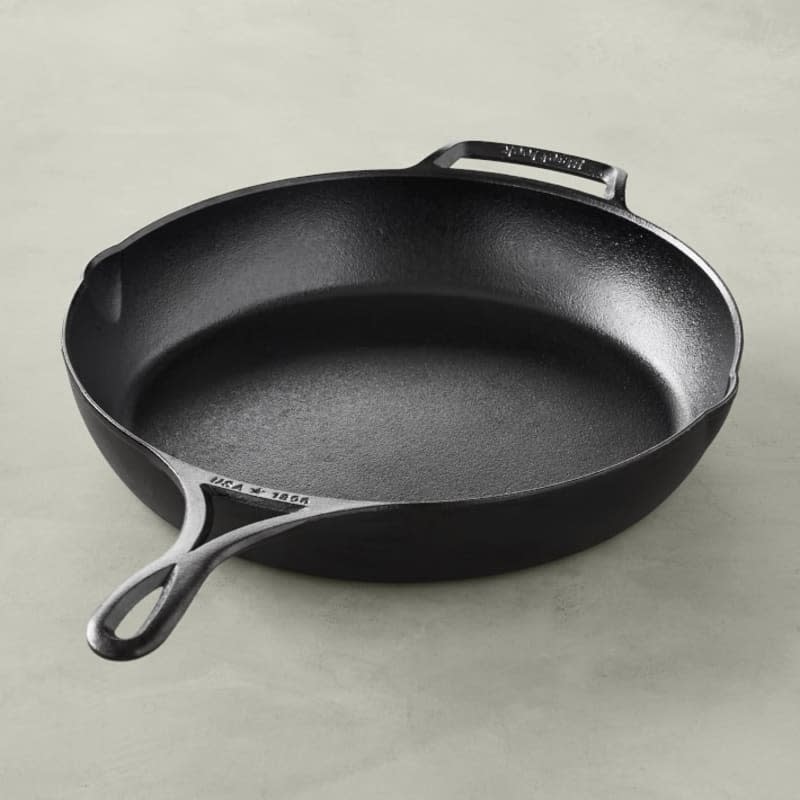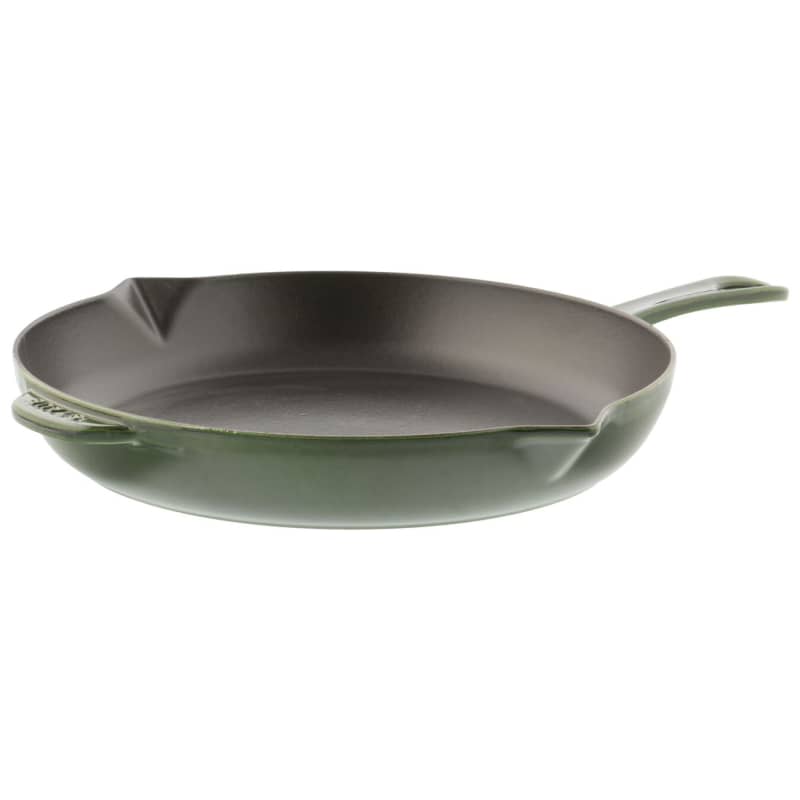The Best Cast Iron Skillets You Can Buy Right Now
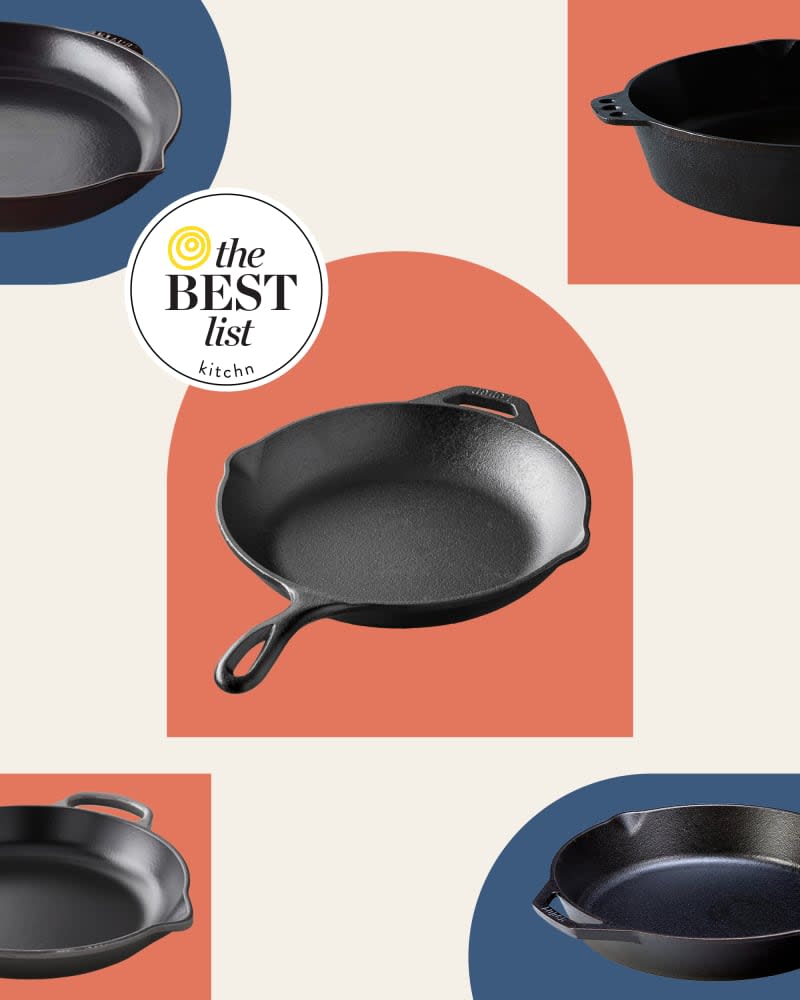
Cast iron skillets have a devoted following like no other class of cookware. And we’re not surprised: they’re durable, versatile, virtually nonstick, and so long-lasting that they can be passed down from generation to generation — literally.
There’s just one million-dollar question: What’s the best cast iron skillet you can buy? To find out, I tested the most popular options, including skillets that cost under $30 as well as high-end, hand-forged skillets that go for hundreds. What did I learn? For starters, my neighbors love, love free cornbread (though I’m not entirely surprised because everyone loves a good cornbread recipe). Also, there are a ton of great cast iron skillets, each with their own nuances to fit various cooking preferences.
For all the details of our testing methodology, along with shopping and maintenance tips, hit the links in the TOC below.
Let’s take a look at the winners.
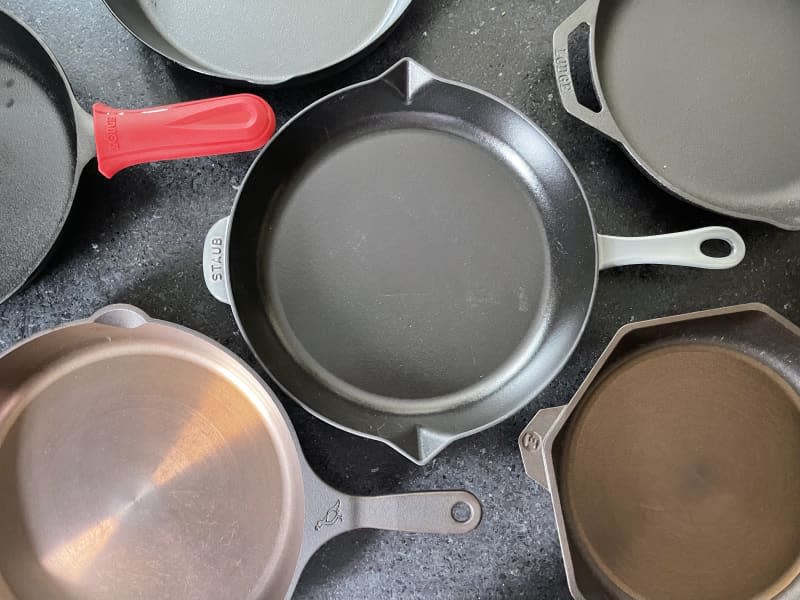
Best Overall Cast Iron Skillet: Lodge Chef Collection Seasoned Cast Iron Skillet
This classic Lodge skillet is a joy to use and cook in. It browns food beautifully and has a helper handle for ease of use. It’s lighter than the other cast iron skillets I tested (right at my ideal 6.5-pound cut off!), which makes it easier to lift and maneuver on the stovetop. The skillet has tall, curved sides that help contain ingredients while still letting you reach in easily to flip food. The skillet has two pouring spouts, so you can use whatever is more convenient when you’re cooking, and a long, solid handle that’s comfortable to grip. Basically, this Lodge skillet has everything you need in a cast iron skillet and nothing you don’t.
Specifications
Weight: 6.5 lb
Wall height: 2 in
Handle length: 5.75 in
Rating Criteria
Performance: 5
Ease of use: 5
Cleanup: 5
Who it’s best for: Anyone who wants a great, basic cast iron skillet that will last years.
Good to know: It’s also available in 10-inch and 8-inch sizes.
Best Splurge Cast Iron Skillet: Smithey Ironware Co. No. 12 Cast Iron Skillet
If you want to splurge on a cast iron skillet, Smithey Ironware is the one to get. This handcrafted skillet arrived with a beautiful, almost caramel-colored surface, which released and browned food beautifully. After searing steak, the surface became blotchy, though the company says this is normal and that, over time, it will “begin to develop a mature (darker) seasoning layer.” Like fine wine, cast iron gets better over time!
Specifications
Weight: 7.8 lb
Wall height: 2.25 in
Handle length: 5.4 in
Rating Criteria
Performance: 5
Ease of use: 5
Cleanup: 5
Who it’s best for: Anyone who wants to invest in a statement-worthy cast iron skillet — and show it off a rack.
Good to know: It comes in a 10-inch size, as well as this teeny-tiny 6-inch size. You can also buy the 12- and 10-inch sizes as part of a griddle-skillet combo.
Best Budget Cast Iron Skillet: Lodge 12-Inch Cast Iron Skillet
For the price, you can’t go wrong with this skillet from Lodge. It thoroughly browns food, and easily builds and maintains its seasoning. It comes preseasoned and gets even better over time — by the end of testing, nothing was sticking at all!
Specifications
Weight: 8 lb
Wall height: 2.25 in
Handle length: 5 in
Rating Criteria
Performance: 5
Ease of use: 4
Cleanup: 5
Who it’s best for: Anyone who wants to spend as little money as possible on a great cast iron skillet.
Good to know: It comes in lots of different sizes, from 3.5 to 15 inches.
Best Lightweight Cast Iron Skillet: Lodge Blacklock Triple Seasoned Cast Iron Skillet
If you find cast iron skillets to be too heavy (and many are), this lighter-weight offering from Lodge is a good option. Weighing in about two pounds less than other models, this skillet is much easier enough to pick up and move around, even when full of food (you know, like cornbread).
Specifications
Weight: 5.8 lb
Wall height: 2.3 in
Handle length: 6 in
Rating Criteria
Performance: 3.5
Ease of use: 4
Cleanup: 5
Who it’s best for: Anyone who finds traditional cast iron skillets too heavy.
Good to know: It comes in three larger sizes, going up to 14.5 inches, with the 10.5-inch version being one of the Kitchn’s favorite cast iron skillets.
Best Enameled Cast Iron Skillet: Staub Enameled Cast Iron Fry Pan
Staub makes one of our favorite enameled cast iron Dutch ovens, so it’s no surprise their cast iron fry pan is also fantastic. It browns food beautifully; has two pour spouts; has a comfortable, ergonomic handle; and has tall, sloped sides that both contain and make it easy to access food.
Specifications
Weight: 6.7 lb
Wall height: 2 in
Handle length: 5.35 in
Rating Criteria
Performance: 5
Ease of use: 4
Cleanup: 5
Who it’s best for: Anyone who is excited to try out cast iron cookware but is intimidated by the seasoning process. (Although I will argue that it’s not an either-or situation and that most home cooks can benefit from having both — more on that reasoning here.)
Good to know: The 12-inch skillet comes in 7 colors, as well as 10-inch and 11-inch sizes.
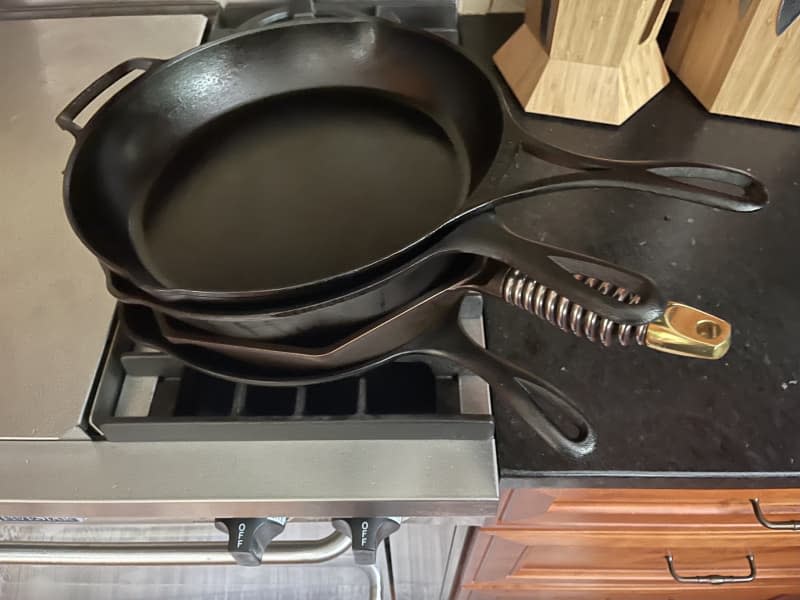
How We Tested the Best Cast Iron Skillets
Make chili-lime steak bites.
Bake skillet cornbread.
Make honey-glazed salmon.
Wash each skillet by hand after each test according to the manufacturers’ instructions.
How We Evaluated the Best Cast Iron Skillets
I judged all of the skillets on the following criteria, on a scale of 1 to 5 (1 being the worst and 5 being the best):
Performance: How well does the skillet cook food?
Ease of use: How easy is the skillet to use?
Cleanup: How easy is it to clean the skillet?
What Makes Cast Iron So Great?
Before getting into the testing methodology, here’s why I think you should have (and use!) a cast iron skillet.
It retains heat extremely well. A cast iron skillet takes longer to heat up than stainless steel or nonstick. But it can withstand high temperatures and, once it heats up, it maintains that heat beautifully. This is what makes cast iron so great at browning and searing things like steak, pork chops, chicken thighs … the list goes on. Its heat retention and durability also make it a great choice for shallow-frying foods, like chicken cutlets, fritters, and donuts.
It gets more nonstick the more you use it. Almost all cast iron skillets are sold pre-seasoned, so you can start cooking right after you unbox it. While you may notice some initial sticking, the more you cook in a cast iron skillet, the more you’ll build up the seasoning — and the more nonstick it’ll become. A great cast iron skillet will only get better with age.
It’s durable (like, very durable). One might even call a cast iron skillet indestructible. (Like this cast iron that was rescued from a burned down house!) You can use cast iron on the stovetop (it’s induction-friendly, too!), in the oven, on the grill (a grilled fruit crisp, anyone?), and even over an open fire. As long as you treat cast iron right and clean it properly, you’re golden. However, if the seasoning gets stripped, no worries! It’s easy to reseason a cast iron skillet, and you can even bring a rusty cast iron skillet back to life!
What to Consider When Buying a Cast Iron Skillet
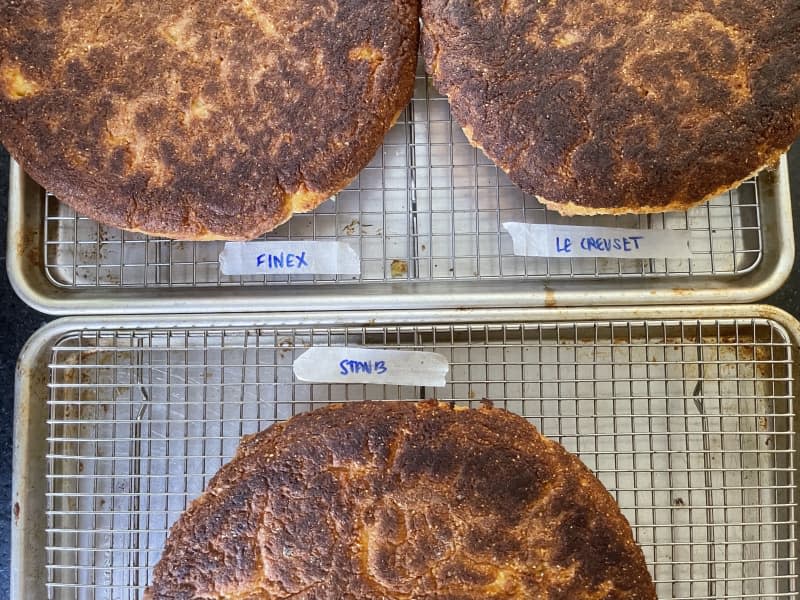
How Well Does It Cook?
Cast iron is naturally heavy, but its heft is what makes it such a superstar for browning. Thick, heavy cast iron skillets conduct and retain heat, which translates to even, thorough browning.
Conversely, lighter options tend to cook more unevenly, as they just don’t have the same amount of material mass to retain heat as well. During my testing, skillets weighing in at 6.5 pounds and above performed the best; they evenly and deeply browned steak, skin-on salmon, and cornbread.
Differences in Surface Texture
The higher-end, hand-forged skillets I tested (like this stunner from Smithey Ironware Co.) came with smooth surfaces. Others, like those from Lodge, have gently textured, pebbly surfaces. Both of these cook wonderfully and were virtually nonstick by the end of testing. A couple of the skillets I tested had super-rough textures, which I can’t recommend because food stuck more to them and it was harder to maintain their seasoning.
How Easy Is the Skillet to Use?
There are several factors that make a skillet easier to use (and some that don’t): the height of the walls, handle design, number of pour spouts, and whether or not it has a helper handle.
Skillets with walls that are about 2 inches high are ideal (any shorter and they don’t easily contain food; too much taller and it makes it harder to maneuver a spatula in the skillet or flip a salmon fillet).
As for the handle design, solid handles feel more secure and are easier to pick up. Handles with intricate designs or with gaps are harder and more uncomfortable to hold onto.
And as for the pouring spouts, some skillets don’t have any, some have one, some have two, and one brand I tested had eight (!!!). Having two spouts was the most helpful in pouring sauces, oil, and ingredients out of the skillet no matter if you’re right- or left-handed. I also prefer skillets that have some sort of helper handle, which makes it more comfortable to maneuver around the stovetop or into and out of the oven.
What Size Skillet Should You Get?
For this test, I focused on 12-inch skillets. This is the ideal size if you often cook for four or make recipes that serve four. A 10-inch skillet is great if you usually cook for two to three. If you’re torn between sizes, go bigger. You can always make less food in a 12-inch skillet, but can’t make more food in a 10-inch.
Is Cast Iron or Enameled Cast Iron Better?
Personally, I think it’s worth having both. But here’s the caveat: If you want the heat-retaining abilities of cast iron, but don’t want to worry about maintaining the seasoning, an enameled cast iron skillet (like my top pick from Staub) is a great option. You can wash it with all the dish soap you want and not worry about drying it on the stovetop or rubbing oil onto its surface, like you’d do with traditional cast iron. Acidic ingredients can also strip the seasoning of traditional cast iron, but not enameled cast iron, making the latter a better choice for pan sauces or simmering meatballs in tomato sauce.
That said, enameled cast iron won’t become more nonstick the more you use it and is less durable than traditional cast iron, as its enameled coating can chip or crack over time.
Why You Should Trust Us
I’m a professional kitchen equipment tester and former tools editor here at Kitchn. I previously worked at America’s Test Kitchen and my reviews on topics like stand mixers, induction burners, toaster ovens, and multicookers have been published in Cook’s Illustrated, Cook’s Country, and on the America’s Test Kitchen website. My work has also been featured on America’s Test Kitchen’s and Cook’s Country’s television programs. I also happen to love cast iron cookware.
Kitchn’s Best List Promise
We will do our homework, going wildly in depth with our testing. But we’ll condense the info into easy, breezy summaries, so that you can see what we picked and why, and then move on with your life. Because we know you’re busy!
More Best Lists
Do you have a question about cast iron skillets? Leave it in the comments!
